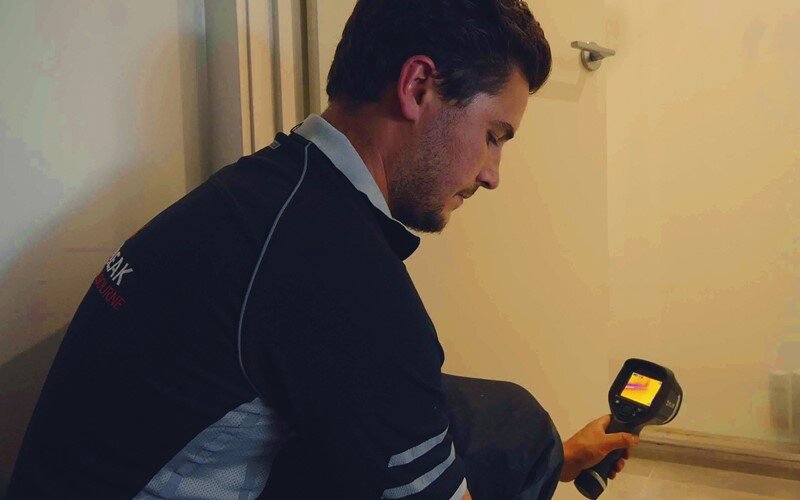How to Locate and also Repair Service Water Leaks-- A Comprehensive Guide
How to Locate and also Repair Service Water Leaks-- A Comprehensive Guide
Blog Article
We've encountered the article pertaining to Locating water leaks down the page on the web and think it made sense to discuss it with you on my blog.

Early detection of leaking water lines can reduce a possible catastrophe. Some tiny water leakages may not be noticeable.
1. Analyze the Water Meter
Every house has a water meter. Inspecting it is a proven way that aids you discover leaks. For beginners, turn off all the water sources. Make certain no one will flush, utilize the faucet, shower, run the cleaning machine or dish washer. From there, go to the meter and watch if it will certainly alter. Because no person is using it, there must be no movements. That shows a fast-moving leak if it moves. If you identify no changes, wait an hour or 2 and also examine back again. This implies you may have a sluggish leakage that might also be below ground.
2. Check Water Consumption
If you detect sudden changes, despite your usage being the exact same, it indicates that you have leakages in your plumbing system. An unexpected spike in your expense indicates a fast-moving leak.
Meanwhile, a steady rise each month, despite the same habits, shows you have a slow leakage that's likewise slowly escalating. Call a plumber to extensively inspect your property, specifically if you really feel a cozy area on your floor with piping below.
3. Do a Food Coloring Test
When it comes to water usage, 30% comes from toilets. If the shade somehow infiltrates your dish during that time without flushing, there's a leak in between the storage tank and bowl.
4. Asses Outside Lines
Don't forget to check your exterior water lines as well. Test spigots by connecting a garden tube. Must water seep out of the connection, you have a loosened rubber gasket. Change this and also make sure all connections are tight. If you've obtained an automatic sprinkler, it will aid get it professionally analyzed and maintained annually. One little leak can throw away lots of water and also spike your water expense.
5. Examine the scenario and evaluate
Homeowners must make it a behavior to check under the sink counters as well as even inside cupboards for any type of bad odor or mold growth. These 2 red flags indicate a leak so timely focus is required. Doing routine assessments, also bi-annually, can save you from a major problem.
If you know your house is currently old, maintain a careful eye on your heaters, hoses, pipelines etc. Check for stainings as well as compromising as many home appliances and pipelines have a life expectancy. They will additionally naturally deteriorate as a result of wear and tear. Don't wait for it to escalate if you suspect dripping water lines in your plumbing system. Call a professional plumber as soon as possible so you do not end up with an awful mess in your house.
Early discovery of leaking water lines can minimize a prospective calamity. Some tiny water leakages might not be noticeable. Checking it is a proven way that aids you discover leaks. One little leak can lose loads of water as well as increase your water expense.
If you presume leaking water lines in your plumbing system, don't wait for it to escalate.
WARNING SIGNS OF WATER LEAKAGE BEHIND THE WALL
PERSISTENT MUSTY ODORS
As water slowly drips from a leaky pipe inside the wall, flooring and sheetrock stay damp and develop an odor similar to wet cardboard. It generates a musty smell that can help you find hidden leaks.
MOLD IN UNUSUAL AREAS
Mold usually grows in wet areas like kitchens, baths and laundry rooms. If you spot the stuff on walls or baseboards in other rooms of the house, it’s a good indicator of undetected water leaks.
STAINS THAT GROW
When mold thrives around a leaky pipe, it sometimes takes hold on the inside surface of the affected wall. A growing stain on otherwise clean sheetrock is often your sign of a hidden plumbing problem.
PEELING OR BUBBLING WALLPAPER / PAINT
This clue is easy to miss in rooms that don’t get much use. When you see wallpaper separating along seams or paint bubbling or flaking off the wall, blame sheetrock that stays wet because of an undetected leak.
BUCKLED CEILINGS AND STAINED FLOORS
If ceilings or floors in bathrooms, kitchens or laundry areas develop structural problems, don’t rule out constant damp inside the walls. Wet sheetrock can affect adjacent framing, flooring and ceilings.
https://www.servicemasterbyzaba.com/blog/how-to-detect-water-leakage-in-walls/

As a reader on Leaking water lines, I was thinking sharing that post was beneficial. Enjoyed reading our write-up? Please share it. Let somebody else locate it. Thanks for your time. Visit again soon.
Report this page